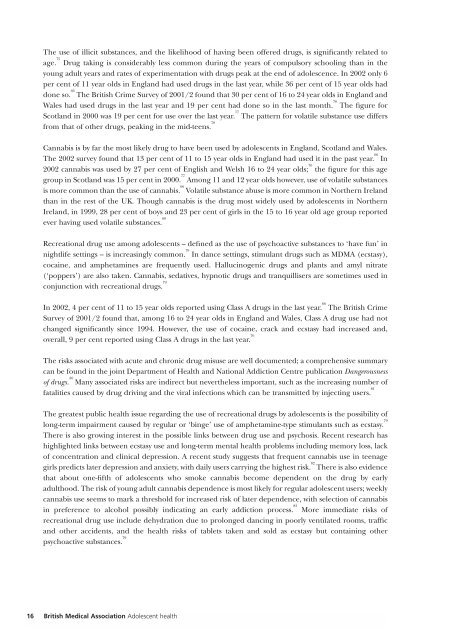Alcohol misuse: tackling the UK epidemic - London
Alcohol misuse: tackling the UK epidemic - London
Alcohol misuse: tackling the UK epidemic - London
Create successful ePaper yourself
Turn your PDF publications into a flip-book with our unique Google optimized e-Paper software.
16<br />
The use of illicit substances, and <strong>the</strong> likelihood of having been offered drugs, is significantly related to<br />
age. 75<br />
Drug taking is considerably less common during <strong>the</strong> years of compulsory schooling than in <strong>the</strong><br />
young adult years and rates of experimentation with drugs peak at <strong>the</strong> end of adolescence. In 2002 only 6<br />
per cent of 11 year olds in England had used drugs in <strong>the</strong> last year, while 36 per cent of 15 year olds had<br />
done so. 66<br />
The British Crime Survey of 2001/2 found that 30 per cent of 16 to 24 year olds in England and<br />
Wales had used drugs in <strong>the</strong> last year and 19 per cent had done so in <strong>the</strong> last month. 76<br />
The figure for<br />
Scotland in 2000 was 19 per cent for use over <strong>the</strong> last year. 77<br />
The pattern for volatile substance use differs<br />
from that of o<strong>the</strong>r drugs, peaking in <strong>the</strong> mid-teens. 78<br />
Cannabis is by far <strong>the</strong> most likely drug to have been used by adolescents in England, Scotland and Wales.<br />
The 2002 survey found that 13 per cent of 11 to 15 year olds in England had used it in <strong>the</strong> past year. 66<br />
In<br />
2002 cannabis was used by 27 per cent of English and Welsh 16 to 24 year olds; 76<br />
<strong>the</strong> figure for this age<br />
group in Scotland was 15 per cent in 2000. 77<br />
Among 11 and 12 year olds however, use of volatile substances<br />
is more common than <strong>the</strong> use of cannabis. 66<br />
Volatile substance abuse is more common in Nor<strong>the</strong>rn Ireland<br />
than in <strong>the</strong> rest of <strong>the</strong> <strong>UK</strong>. Though cannabis is <strong>the</strong> drug most widely used by adolescents in Nor<strong>the</strong>rn<br />
Ireland, in 1999, 28 per cent of boys and 23 per cent of girls in <strong>the</strong> 15 to 16 year old age group reported<br />
ever having used volatile substances. 69<br />
Recreational drug use among adolescents – defined as <strong>the</strong> use of psychoactive substances to ‘have fun’ in<br />
nightlife settings – is increasingly common. 79<br />
In dance settings, stimulant drugs such as MDMA (ecstasy),<br />
cocaine, and amphetamines are frequently used. Hallucinogenic drugs and plants and amyl nitrate<br />
(‘poppers’) are also taken. Cannabis, sedatives, hypnotic drugs and tranquillisers are sometimes used in<br />
conjunction with recreational drugs. 79<br />
In 2002, 4 per cent of 11 to 15 year olds reported using Class A drugs in <strong>the</strong> last year. 66<br />
The British Crime<br />
Survey of 2001/2 found that, among 16 to 24 year olds in England and Wales, Class A drug use had not<br />
changed significantly since 1994. However, <strong>the</strong> use of cocaine, crack and ecstasy had increased and,<br />
overall, 9 per cent reported using Class A drugs in <strong>the</strong> last year. 76<br />
The risks associated with acute and chronic drug <strong>misuse</strong> are well documented; a comprehensive summary<br />
can be found in <strong>the</strong> joint Department of Health and National Addiction Centre publication Dangerousness<br />
of drugs. 80<br />
Many associated risks are indirect but never<strong>the</strong>less important, such as <strong>the</strong> increasing number of<br />
fatalities caused by drug driving and <strong>the</strong> viral infections which can be transmitted by injecting users. 81<br />
The greatest public health issue regarding <strong>the</strong> use of recreational drugs by adolescents is <strong>the</strong> possibility of<br />
long-term impairment caused by regular or ‘binge’ use of amphetamine-type stimulants such as ecstasy. 79<br />
There is also growing interest in <strong>the</strong> possible links between drug use and psychosis. Recent research has<br />
highlighted links between ecstasy use and long-term mental health problems including memory loss, lack<br />
of concentration and clinical depression. A recent study suggests that frequent cannabis use in teenage<br />
girls predicts later depression and anxiety, with daily users carrying <strong>the</strong> highest risk. 82<br />
There is also evidence<br />
that about one-fifth of adolescents who smoke cannabis become dependent on <strong>the</strong> drug by early<br />
adulthood. The risk of young adult cannabis dependence is most likely for regular adolescent users; weekly<br />
cannabis use seems to mark a threshold for increased risk of later dependence, with selection of cannabis<br />
in preference to alcohol possibly indicating an early addiction process. 83<br />
More immediate risks of<br />
recreational drug use include dehydration due to prolonged dancing in poorly ventilated rooms, traffic<br />
and o<strong>the</strong>r accidents, and <strong>the</strong> health risks of tablets taken and sold as ecstasy but containing o<strong>the</strong>r<br />
psychoactive substances. 79<br />
British Medical Association Adolescent health
















